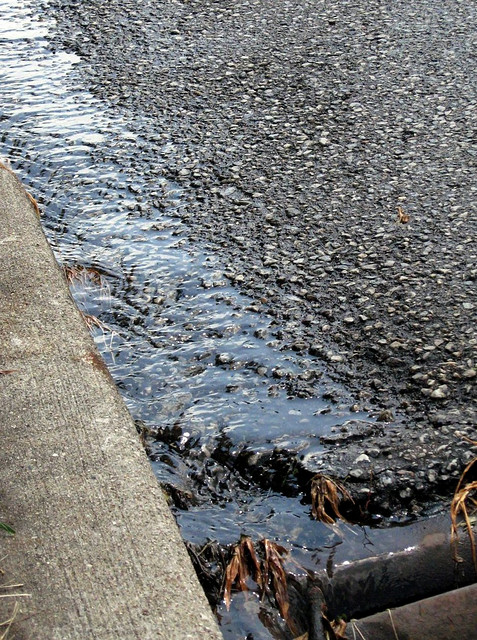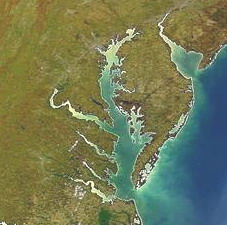Commentary: Now’s the time to take action against urban-suburban runoff
By Kim Coble
We are making progress reducing pollution from agricultural lands and sewage treatment plants. But polluted runoff from urban and suburban streets, parking lots, rooftops, and other impervious surfaces keeps increasing.
Polluted runoff from urban and suburban areas creates flooding, can threaten human health and carries toxic chemicals into local waterways. In developed areas, it can be a significant contributor to the impairment of streams and rivers.
For example, in Anne Arundel County, the Public Works Department estimates that runoff from city streets and suburban parking lots contributes more than 880,000 pounds of nitrogen pollution to local waterways every year. This is more than the nitrogen pollution from agriculture and septic systems combined.
But in Anne Arundel County and other major urban and suburban areas, the way stormwater is treated will be changing.
New permits will soon require many jurisdictions to do much more to both reduce and monitor pollution to ensure that reductions are actually occurring.
Traditional stormwater management must change
Traditional stormwater management, which moved water as quickly as possible off roadways and parking lots, will need to be supplemented with new technologies that in many places allow rainwater to seep into the ground, reducing the volume of pollution reaching local rivers and streams. This should reduce both pollution and regular flooding. But it will come with additional costs.
In Virginia, 18 local jurisdictions already have approved fees or taxes to support better management of urban and suburban polluted runoff, and seven more jurisdictions are considering dedicated funding. In addition, this year the Virginia General Assembly established a new state fund providing $35 million in matching grants to assist local governments to better manage stormwater.
Maryland passed a law that required the 10 largest jurisdictions to implement dedicated funding to meet the new requirements. Prince George’s County went a step further, and is setting up a public/private partnership to be responsible for overseeing the installation and management of stormwater controls on public property. Officials hope that they can leverage private investment and expect that 5,000 jobs will be created in the next 10 years.
Economic benefits
There are other economic benefits as well. The University of Maryland Environmental Finance Center studied the economic impact and found that for every $100 million invested in stormwater in Anne Arundel County, there will be $220 million in benefit to the local economy.
In Washington, D.C., where approximately 43% of the land area is composed of rooftops, parking lots and other impervious surfaces, new stormwater retention performance standards are in place to reduce the harmful impacts to the Anacostia and Potomac rivers, Rock Creek and their tributaries.
The district also has a rebate program for individuals and businesses that want to install green roofs.
In Pennsylvania this year, the General Assembly passed legislation that allows local governments to establish stormwater authorities. This allows authorities to establish a process for collecting fees or taxes to support the reduction of pollution from stormwater. Many local governments are already discussing implementation.
Lancaster is among the jurisdictions considering a fee or tax. City officials estimate they could cut stormwater costs from $300 million to $140 million with infrastructure like porous pavers, green roofs and increased tree canopy.
Green infrastructure has the added benefit of improving the quality of life in cities and towns.
Runoff harms local waterways
Polluted urban and suburban runoff has significantly impaired local waterways. These are local problems that require local solutions. Some are big, like replacing stormwater systems. Some are things we can all do, like installing rain barrels, planting more trees or building rain gardens.
The progress made in reducing pollution from agriculture and sewage treatment plants shows what can be done when governments, businesses and citizens work together. Progress reducing polluted runoff from urban and suburban areas doesn’t need to happen overnight, but work needs to begin now.
While these signs of progress are reassuring, not all elected officials are on board. One of the largest threats to restoring local rivers, streams, and the Chesapeake Bay are those officials who focus on high costs and say it can’t be done. To them I say look around and see what others have done, embrace new techniques and technologies — and remember that the public overwhelmingly wants clean water.
This is truly the moment in time for cleaning up our waters. There is a Clean Water Blueprint in place to guide the state and local governments, and many are beginning to implement the practices that will result in cleaner water.
Our children and grandchildren will thank us for saving our local rivers, streams and the Chesapeake Bay, but that will only happen if we continue the hard work and investments needed to achieve the goal.
Let’s get to work and finish the job.
Kim Coble is vice president for environmental protection and restoration at the Chesapeake Bay Foundation. Distributed by Bay Journal News Service.
Readers can leave comments about this article below.

MarylandReporter.com is a daily news website produced by journalists committed to making state government as open, transparent, accountable and responsive as possible – in deed, not just in promise. We believe the people who pay for this government are entitled to have their money spent in an efficient and effective way, and that they are entitled to keep as much of their hard-earned dollars as they possibly can.




